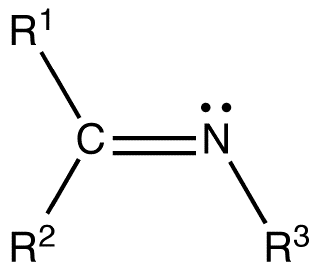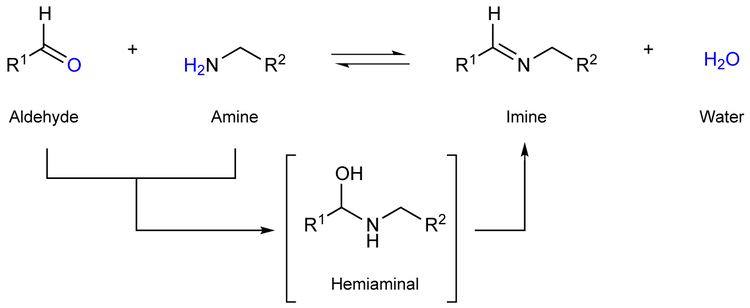 | ||
Organic chemistry 51c lecture 06 formation of imines enamines from aldehydes ketones
An imine (/ᵻˈmiːn/ or /ˈɪmɪn/) is a functional group or chemical compound containing a carbon–nitrogen double bond. The Nitrogen atom can be attached to a hydrogen (H) or an organic group (R). If this group is not a hydrogen atom, then the compound can sometimes be referred to as a Schiff base. The carbon atom has two additional single bonds.
Contents
- Organic chemistry 51c lecture 06 formation of imines enamines from aldehydes ketones
- Nomenclature and classification
- Synthesis of imines
- More specialized methods
- Imine reactions
- Acid base reactions
- As ligands
- Imine reductions
- Biological role
- References

Nomenclature and classification

Usually imines refer to compounds with the connectivity R2C=NR, as discussed below. In the older literature, imine refers to the aza analogue of an epoxide. Thus, ethyleneimine is the three-membered ring species C2H4NH.

Imines are related to ketones and aldehydes by replacement of the oxygen with an NR group. When R = H, the compound is a primary imine, when R is hydrocarbyl, the compound is a secondary imine. Imines exhibit diverse reactivity and are commonly encountered throughout chemistry. When R3 is OH, the imine is called an oxime, and when R3 is NH2 the imine is called a hydrazone.

A primary imine in which C is attached to both a hydrocarbyl and a H is called a primary aldimine; a secondary imine with such groups is called a secondary aldimine. A primary imine in which C is attached to two hydrocarbyls is called a primary ketimine; a secondary imine with such groups is called a secondary ketimine .
One way of naming aldimines is to take the name of the radical, remove final "e", and add "-imine", for example ethanimine. See the aldimine article for other naming conventions. Alternately, an imine is named as a derivative of a carbonyl, adding the word "imine" to the name of a carbonyl compound whose oxo group is replaced by an imino group, for example sydnone imine and acetone imine (an intermediate in the synthesis of acetone azine).
N-Sulfinyl imines are a special class of imines having a sulfinyl group attached to the nitrogen atom.
Synthesis of imines
Imines are typically prepared by the condensation of primary amines and aldehydes and less commonly ketones:
RNH2 + R'C(O)R → RN=C(R')(R) + H2OIn terms of mechanism, such reactions proceed via the nucleophilic addition giving a hemiaminal -C(OH)(NHR)- intermediate, followed by an elimination of water to yield the imine. (see alkylimino-de-oxo-bisubstitution for a detailed mechanism) The equilibrium in this reaction usually favors the carbonyl compound and amine, so that azeotropic distillation or use of a dehydrating agent, such as molecular sieves or magnesium sulfate, is required to push the reaction in favor of imine formation. In recent years, several reagents such as Tris(2,2,2-trifluoroethyl)borate [B(OCH2CF3)3], pyrrolidine or Titanium Ethoxide [Ti(OEt)4] have been shown to catalyse imine formation.
More specialized methods
Several other methods exist for the synthesis of imines.
Imine reactions
The most important reactions of imines are their hydrolysis to the corresponding amine and carbonyl compound. Otherwise this functional group participates in many other reactions, many of which are analogous to the reactions of aldehydes and ketones.
Acid-base reactions
Somewhat like the parent amines, imines are mildly basic and reversibly protonate to give iminium salts. Iminium derivatives are particularly susceptible to reduction to the amines using transfer hydrogenation or by the stoichiometric action of sodium cyanoborohydride. Since imines derived from unsymmetrical ketones are prochiral, their reduction is a useful method for the synthesis of chiral amines.
As ligands
Imines are common ligands in coordination chemistry. The condensation of salicylaldehyde and ethylenediamine give families of imine-containing chelating agents such as salen.
Imine reductions
An imine can be reduced to an amine via hydrogenation for example in a synthesis of m-tolylbenzylamine:
Other reducing agents are lithium aluminium hydride and sodium borohydride.
The first asymmetric imine reduction was reported in 1973 by Kagan using Ph(Me)C=NBn and PhSiH2 in a hydrosilylation with chiral ligand DIOP and rhodium catalyst (RhCl(CH2CH2)2)2. Many systems have since been investigated.
Biological role
Imines are common in nature. Vitamin B6 promotes the deamination of amino acids via the formation of imines, for example.
